Iowa Eye Association News
Nov. 2003. Series 2, no. 38.
Department of Ophthalmology and Visual Sciences
Iowa Eye Association News Nov. 2003. Series 2, no. 38. |
University
of Iowa
Department of Ophthalmology and Visual Sciences |
Thomas A. Weingeist,
PhD, MD, 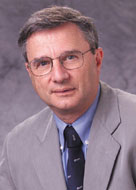 will
be honored at the 2003 American Academy of Ophthalmology Annual Meeting
in Anaheim, California with a Life Achievement Honor Award for his contribution
to the Academy, its scientific and educational programs and to ophthalmology.
In December, Dr. Weingeist ends his term as Past-President and member of
the Board of Trustees of the Academy which he began in 1992. He has participated
in courses, symposia, educational and scientific exhibits at AAO annual
meetings since 1968 when he gave a course with the late George Smelser,
PhD, on the ultrastructure of the eye and adnexa. will
be honored at the 2003 American Academy of Ophthalmology Annual Meeting
in Anaheim, California with a Life Achievement Honor Award for his contribution
to the Academy, its scientific and educational programs and to ophthalmology.
In December, Dr. Weingeist ends his term as Past-President and member of
the Board of Trustees of the Academy which he began in 1992. He has participated
in courses, symposia, educational and scientific exhibits at AAO annual
meetings since 1968 when he gave a course with the late George Smelser,
PhD, on the ultrastructure of the eye and adnexa. |
|
| The Iowa Academy of Ophthalmology has selected Thomas A. Weingeist, PhD, MD, Professor and Head of the University of Iowa Department of Ophthalmology and Visual Sciences, as Eye Health Advocate for 2003. |
| Sara L. Butterworth, OD, was named the Young Optometrist of the Year for the State at the Iowa Optometric Association 2003 Annual Congress. Dr. Butterworth was also named a Fellow of the American Academy of Optometry in December, 2002. |  |
Ronald V. Keech,
MD, 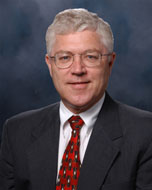 received
the Walt and Lilly Disney Award for Amblyopia Research in the amount of
$25,000 from Research to Prevent Blindness (RPB). The RPB Disney Awards
for Amblyopia Research are meant to stimulate, strengthen, and promote research
to improve the diagnosis and treatment of amblyopia. The grants are offered
to exceptional ophthalmic scientists in pursuit of research of unusual significance
and promise in this area. Dr. Keech is one of two scientists selected to
receive the award in 2003. received
the Walt and Lilly Disney Award for Amblyopia Research in the amount of
$25,000 from Research to Prevent Blindness (RPB). The RPB Disney Awards
for Amblyopia Research are meant to stimulate, strengthen, and promote research
to improve the diagnosis and treatment of amblyopia. The grants are offered
to exceptional ophthalmic scientists in pursuit of research of unusual significance
and promise in this area. Dr. Keech is one of two scientists selected to
receive the award in 2003. |
|
Gregory S.
Hageman, PhD, Dr. Hageman has been awarded a supplement of nearly $400,000 on his NIH R01 grant "Age-Related Maculopathy: Cellular and Molecular Analyses". The money will be used for the purchase of an Olympus Fluoview FV500 laser scanning confocal microscope. The microscope will facilitate studies by Dr. Hageman and his colleagues that are directed towards identifying genes and pathways associated with the development of age-related macular degeneration, a leading cause of blindness worldwide. The microscope will be particularly useful in assessing the distribution of proteins and other molecules in eyes that are obtained from donors with and without this devastating disease. |
|
Sohan Singh Hayreh, MD, MS, PhD, FRCS, FRCOphth, DSc, visited India in January and February. He was the invited speaker at the All India Ophthalmological Society Annual Conference in New Dehli, the International Ophthalmic Conference on Eye Trends at Coimbatore, India, and the Annual Congress of the Vitreo-Retinal Society of India in Chandigarh, India. He delivered a keynote address and lectures at the 50th Anniversary of the Indian Journal of Ophthalmology and at a symposium on Foundation of Ophthalmology in India. He also was invited to give lectures at the L.V. Prasad Eye Institute and the National Institute of Medical Sciences in Hyderabad. Dr. Hayreh also delivered the ARVO Weisenfeld Lecture in May. Dr. Hayreh was honored at the 2003 Annual Meeting of the Iowa Eye Association in June where he also delivered the Braley Lecture.
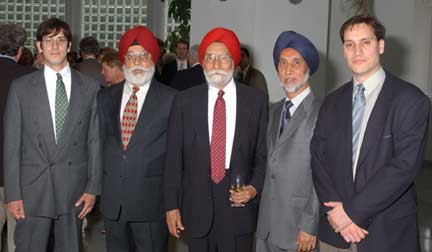 |
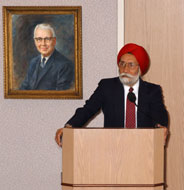 |
| Left to right: Ravinder Graham Singh Hayreh, Manmohinder Singh Hayreh, Sohan Singh Hayreh, Sant Manmohan Singh Hayreh, Davinder James Singh Hayreh | Dr.
Hayreh delivered the Braley Lecture |
Robert F. Mullins, PhD, has received funding for a National Institutes of Health R03 grant. This is a three-year grant for $100,000 direct costs per year and about $441,000 total costs over the three years. The title of the proposal is: "The choriocapillaris in aging and macular disease." The goal of the proposal is to test the hypothesis that changes in immune function of the choriocapillaris are involved in the pathogenesis of age-related macular degeneration. This hypothesis will be addressed by examining gene and protein expression in human eyes with and without macular degeneration, as well as by developing cell culture and organ culture systems for choriocapillaris endothelial cells.
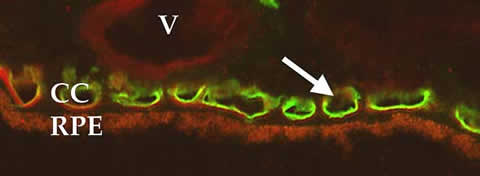 |
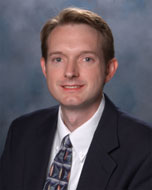 |
| Distribution of vascular markers in the choroid. Red labeling corresponds to endogenous alkaline phosphatase activity of choroidal endothelial cells. Green labeling corresponds to expression of carbonic anhydrase IV by choriocapillary endothelial cells. RPE, retinal pigment epithelium; CC, choriocapillaris. | Dr. Rob Mullins |
Thomas A. Oetting, MD, (photograph below) has been selected to be on the ABO and AAO knowledge base panel for cataract and anterior segment surgery. This panel will join others to develop the recertification knowledge base.
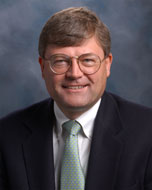 Stephen
R. Russell, MD, as a visiting faculty for Project Orbis, made a trip
to the Vietnam National Institute of Ophthalmology (VNIO) in Hanoi, Vietnam.
His aim was to provide instruction on the surgical treatment of retinopathy
of prematurity which has become epidemic in that country due to the increased
survival of very premature infants. While there, he delivered five lectures
and operated on seven complicated retinal detachment patients. He donated
several books provided by the C. S. O'Brien Library including a two-volume
set on ophthalmic surgery translated by Dr. Fred Blodi. Dr. Russell also
donated an intraocular forceps and scissors to allow treatment of complicated
retinal cases, as VNIO did not have these resources. Stephen
R. Russell, MD, as a visiting faculty for Project Orbis, made a trip
to the Vietnam National Institute of Ophthalmology (VNIO) in Hanoi, Vietnam.
His aim was to provide instruction on the surgical treatment of retinopathy
of prematurity which has become epidemic in that country due to the increased
survival of very premature infants. While there, he delivered five lectures
and operated on seven complicated retinal detachment patients. He donated
several books provided by the C. S. O'Brien Library including a two-volume
set on ophthalmic surgery translated by Dr. Fred Blodi. Dr. Russell also
donated an intraocular forceps and scissors to allow treatment of complicated
retinal cases, as VNIO did not have these resources. |
|
Edwin Stone,
MD, PhD,  recently
received The Foundation Fighting Blindness "Trustee Award". The
award is presented each year to the researcher who made the largest contribution
in the fight against blindness. The "Trustee Award" serves as
a symbol of research excellence in the field of retinal degeneration research.
Dr. Stone was recognized for his contributions to the genetics of retinal
degenerative disease. recently
received The Foundation Fighting Blindness "Trustee Award". The
award is presented each year to the researcher who made the largest contribution
in the fight against blindness. The "Trustee Award" serves as
a symbol of research excellence in the field of retinal degeneration research.
Dr. Stone was recognized for his contributions to the genetics of retinal
degenerative disease. |
|
| Center for Macular Degeneration Director and Professor of Ophthalmology, Edwin M. Stone, MD, PhD, with collaborators, Thomas L. Casavant, PhD, and Andrew Williams, PhD, have won a 3-year $771,000 grant from the National Institutes of Health for a research project that uses artificial intelligence to search for inherited causes of blindness. Dr. Casavant is director of the UI Center for Bioinformatics and Computational Biology, professor of electrical and computer engineering and biomedical engineering and has a secondary appointment with the Department of Ophthalmology & Visual Sciences. Dr. Williams is assistant professor of electrical and computer engineering. The project is funded through the National Eye Institute, Biomedical Information Science and Technology Initiative (BISTI). | 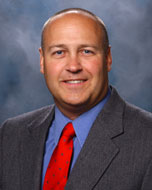 Dr. Casavant |
John E. Sutphin,
MD, 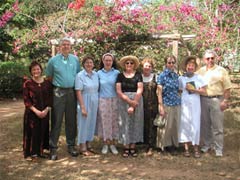 made
a return trip to Haiti in January. Liz Bulgarelli, RN, made the Haiti
trip for the first time this year. The mission this year was made under
the auspices of the Christian Mission of Pignon, Inc. made
a return trip to Haiti in January. Liz Bulgarelli, RN, made the Haiti
trip for the first time this year. The mission this year was made under
the auspices of the Christian Mission of Pignon, Inc. |
|
 Markus
Kuehn, PhD, has been appointed as an Associate Research Scientist with the
department. His work centers primarily on the cell biology of glaucoma but he
also has an interest in the developmental biology of the retina. Together with
Dr. Young Kwon and collaborators at Iowa State University, he utilizes an animal
model to understand how increased intraocular pressure leads to ganglion cell
death in the glaucomatous eye. A second research project focuses on the role
of a retina-specific transcription factor in retinal development and why mutations
in this factor give rise to Enhanced S-Cone Syndrome.
Markus
Kuehn, PhD, has been appointed as an Associate Research Scientist with the
department. His work centers primarily on the cell biology of glaucoma but he
also has an interest in the developmental biology of the retina. Together with
Dr. Young Kwon and collaborators at Iowa State University, he utilizes an animal
model to understand how increased intraocular pressure leads to ganglion cell
death in the glaucomatous eye. A second research project focuses on the role
of a retina-specific transcription factor in retinal development and why mutations
in this factor give rise to Enhanced S-Cone Syndrome.
Dr. Kuehn graduated from the Cell and Molecular Biology Program at St. Louis University in St. Louis and followed his mentor, Dr. Greg Hageman, to Iowa shortly before completion of his studies. Following graduation, he remained in Dr. Hageman's lab as a post-doctoral fellow and engaged in studies towards identification of abnormal gene expression patterns that may be associated with the development of age-related macular degeneration.
Stephen R. Russell, MD, and
Gregory S. Hageman, PhD, made a trip to Rapa Nui, Chile (Easter Island)
in June. In 2002,  Dr.
Hageman started looking into a group of genes that he suspected might modulate
human susceptibility to age-related macular degeneration (AMD). Studying this
group of genes in a heterogeneous population, such as that found in the U.S.,
would be prohibitive. The group of genes is also human specific, so monkey studies
would not suffice. Following a hunch he had, Dr. Hageman predicted that the
natives of Rapa Nui would have no AMD. His hunch turns out to be true. As Dr.
Russell wrote in an email the day before returning "Having seen 550 natives
and drawn blood for macular degeneration research on about half of the population
over age 60, virtually none of them have drusen; none have exudative disease."
Dr. Hageman explains that there were plenty of subjects in their 80's and 90's,
making this an excellent population to study. The blood samples collected during
the trip should help immensely in understanding one of the genetic perspectives
of AMD. The trip has given him a lead on another tribe in Chile that could result
in further study. Dr. Rodrigo Poblete (former Iowa Oculoplastics Fellow) played
a key role in Chile. Besides helping to work with the ethics committee and other
regulating agencies in Chile, he managed to recruit seven people to volunteer
a week of their time to help with the project.
Dr.
Hageman started looking into a group of genes that he suspected might modulate
human susceptibility to age-related macular degeneration (AMD). Studying this
group of genes in a heterogeneous population, such as that found in the U.S.,
would be prohibitive. The group of genes is also human specific, so monkey studies
would not suffice. Following a hunch he had, Dr. Hageman predicted that the
natives of Rapa Nui would have no AMD. His hunch turns out to be true. As Dr.
Russell wrote in an email the day before returning "Having seen 550 natives
and drawn blood for macular degeneration research on about half of the population
over age 60, virtually none of them have drusen; none have exudative disease."
Dr. Hageman explains that there were plenty of subjects in their 80's and 90's,
making this an excellent population to study. The blood samples collected during
the trip should help immensely in understanding one of the genetic perspectives
of AMD. The trip has given him a lead on another tribe in Chile that could result
in further study. Dr. Rodrigo Poblete (former Iowa Oculoplastics Fellow) played
a key role in Chile. Besides helping to work with the ethics committee and other
regulating agencies in Chile, he managed to recruit seven people to volunteer
a week of their time to help with the project.
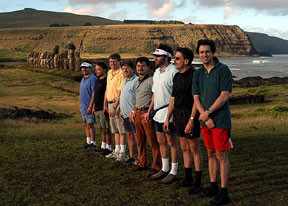
 |
 |
Dr. Tim Johnson |
Dr. Tom Oetting |
A. Tim Johnson, MD, PhD, and Thomas A. Oetting, MD, are participating in a study with Ophthtec Corporation in which they are placing iris reconstruction intraocular lenses. This device is an artificial iris and intraocular lens combination that comes in four colors. They have had promising results. (see photographs below) Drs. Oetting and Johnson have also placed numerous capsular tension rings as part of a study to obtain FDA approval for the Ophthtec Capsular Tension Ring. Approval is expected within the year.
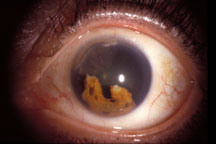 |
Eye with cataract and damaged iris | 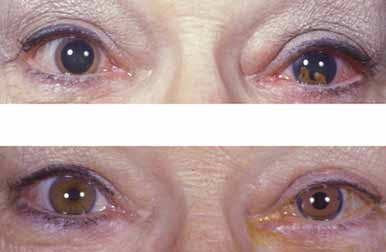 |
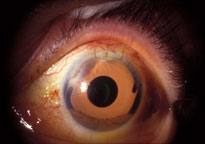 |
Same eye post-operatively |
(requires Adobe Acrobat Reader) |
|||
| "Together,
we have a vision for the future." |
Copyright
© University of Iowa, 2003 |
||